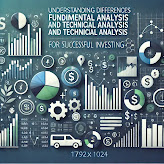What is Fundamental Analysis vs. Technical Analysis?
Outline
Introduction
- Brief overview of investing strategies
- Importance of understanding analysis methods
What is Fundamental Analysis?
- Definition and purpose
- Key components in fundamental analysis
Understanding Company Fundamentals
- Analysis of financial statements
- Revenue, profit, and asset evaluation
Macroeconomic Factors in Fundamental Analysis
- Economic indicators (GDP, inflation)
- Interest rates and market conditions
Qualitative Factors in Fundamental Analysis
- Company management and structure
- Brand value, competitive advantage, and market position
Advantages of Fundamental Analysis
- Long-term perspective
- In-depth company insight
Limitations of Fundamental Analysis
- Time-consuming nature
- Dependence on market assumptions
What is Technical Analysis?
- Definition and purpose
- Emphasis on market data and price movements
Key Components of Technical Analysis
- Charts, patterns, and trends
- Volume, price action, and indicators
Popular Technical Analysis Indicators
- Moving averages
- Relative Strength Index (RSI)
- Bollinger Bands
Advantages of Technical Analysis
- Focus on short-term movements
- Simplicity and quick decision-making
Limitations of Technical Analysis
- High sensitivity to market noise
- Limited long-term insight
Fundamental vs. Technical Analysis: Key Differences
- Short-term vs. long-term approach
- Financial data vs. market patterns
Choosing the Right Approach for Different Investors
- Investors' goals and time frames
- Combining both analysis types
Conclusion
- Summary of both methods
- Importance of aligning analysis with investment goals
FAQs
- What is better, fundamental or technical analysis?
- Can beginners use both fundamental and technical analysis?
- How often should you perform fundamental analysis?
- Is technical analysis useful for long-term investing?
- Which type of analysis suits day trading?
Understanding the Differences Between Fundamental Analysis and Technical Analysis for Successful Investing
Investing can be a complex journey, full of decisions that shape your financial future. One of the most crucial parts of this journey is understanding how to analyze your investments. Two widely used methods of analysis in the world of finance are fundamental analysis and technical analysis. But what sets them apart? And which one should you use? Let’s dive in and find out.
What is Fundamental Analysis?
Fundamental analysis involves studying a company’s intrinsic value by examining key elements, such as its financial health, competitive landscape, and industry position. This method provides investors with insight into whether a stock is undervalued or overvalued compared to its market price, making it a popular tool for long-term investors.
Understanding Company Fundamentals
At the core of fundamental analysis is the evaluation of a company’s financials. This involves closely examining financial statements, which include income statements, balance sheets, and cash flow statements. For instance, a company’s revenue growth, net profit, and asset-to-debt ratios give essential clues about its financial stability and potential for future growth.
Revenue, Profit, and Asset Evaluation
Revenue and profit margins provide a glimpse into how well a company is managing its costs and generating income, which can indicate sustainable growth. Assets and liabilities, on the other hand, help investors understand how a company finances its operations and its ability to withstand economic downturns.
Macroeconomic Factors in Fundamental Analysis
Beyond a company’s internal performance, fundamental analysis also considers the broader economy. Economic indicators like GDP growth, inflation rates, and interest rates can heavily impact a company’s performance and stock price. For instance, a rise in interest rates can increase borrowing costs for a business, affecting its profitability.
Qualitative Factors in Fundamental Analysis
Qualitative analysis delves into aspects of a business that aren’t as easy to quantify, such as the company’s brand value, management quality, and competitive advantage. By looking at a company’s leadership team, market positioning, and brand loyalty, investors can gain insights into its potential for growth and resilience in the face of competition.
Advantages of Fundamental Analysis
- Long-Term Perspective: Fundamental analysis allows investors to make decisions based on a company’s potential for growth over an extended period.
- In-depth Company Insight: By examining both financial and qualitative factors, investors get a comprehensive understanding of a business’s value.
Limitations of Fundamental Analysis
- Time-Consuming: Fundamental analysis requires a detailed study of financial statements and economic conditions, which can be a time-intensive process.
- Market Assumptions: This method assumes that the market will eventually reflect a company’s intrinsic value, but markets don’t always behave predictably in the short term.
What is Technical Analysis?
Unlike fundamental analysis, which is rooted in a company’s financial health, technical analysis focuses on historical price data and trading volume. This approach primarily serves short-term traders looking to capitalize on quick price movements rather than long-term investors.
Key Components of Technical Analysis
Technical analysts use various charts and graphs to identify trends and patterns that might indicate future price movements. Patterns like “head and shoulders,” “double top,” or “cup and handle” are just a few examples of setups that traders use to make buying or selling decisions.
Charts, Patterns, and Trends
Technical analysis relies heavily on chart analysis to determine past and current trends. By studying price charts, traders can see support and resistance levels, which help in predicting potential breakout or breakdown points.
Popular Technical Analysis Indicators
- Moving Averages: This indicator smooths out price data, providing a clearer view of the trend over time.
- Relative Strength Index (RSI): The RSI helps traders understand if a stock is overbought or oversold, indicating possible reversals.
- Bollinger Bands: Bollinger Bands create a price “channel” that helps traders identify potential entry and exit points based on volatility.
Advantages of Technical Analysis
- Focus on Short-Term Movements: This method is well-suited for traders looking to make quick decisions.
- Simplicity: Technical analysis tools can be learned quickly and applied across various markets, making it ideal for day traders and swing traders.
Limitations of Technical Analysis
- Market Noise: Technical analysis is sensitive to short-term market fluctuations, which can lead to false signals.
- Limited Long-Term Insight: Since it primarily looks at past price data, technical analysis doesn’t provide much insight into a company’s long-term potential.
Fundamental vs. Technical Analysis: Key Differences
The main difference between fundamental and technical analysis lies in their focus and time frame. While fundamental analysis looks at long-term financial data and qualitative factors, technical analysis is all about short-term market patterns. Fundamental analysis seeks to understand a company’s intrinsic value, whereas technical analysis revolves around price and volume data to forecast short-term price movements.
Choosing the Right Approach for Different Investors
Which method should you use? It depends on your investment goals. Long-term investors often rely on fundamental analysis to choose stocks with strong growth potential. In contrast, traders interested in short-term profits might lean on technical analysis to catch quick market trends. Some investors use a combination of both methods to balance their portfolios and adapt to changing market conditions.
Conclusion
Both fundamental and technical analyses offer unique insights that can be valuable to investors. Fundamental analysis provides a deep understanding of a company’s intrinsic value, making it suitable for long-term investments. Technical analysis, however, offers quick entry and exit signals, perfect for short-term trades. Ultimately, your choice depends on your goals, investment horizon, and risk tolerance. For many investors, a balanced approach that combines both methods can provide a comprehensive view and improve decision-making.
FAQs
What is better, fundamental or technical analysis?
Each has its strengths: fundamental analysis is great for long-term investing, while technical analysis suits short-term trading.Can beginners use both fundamental and technical analysis?
Yes, beginners can learn and apply both methods, though starting with one can make the learning curve easier.How often should you perform fundamental analysis?
It depends, but typically once every quarter is a good frequency for long-term investors.Is technical analysis useful for long-term investing?
It’s not as effective for long-term investing, as it focuses on short-term price movements rather than intrinsic value.Which type of analysis suits day trading?
Technical analysis is ideal for day trading since it focuses on short-term price trends and patterns.






